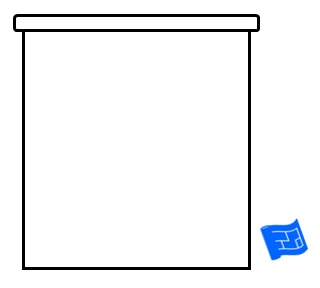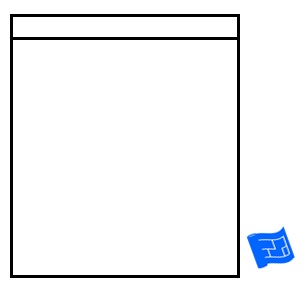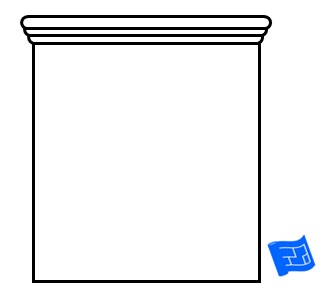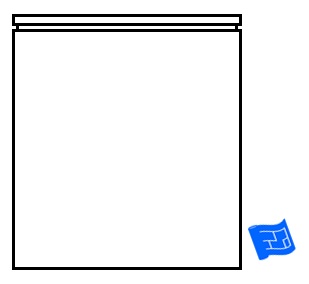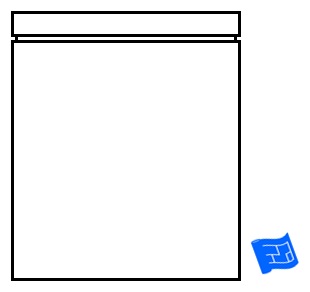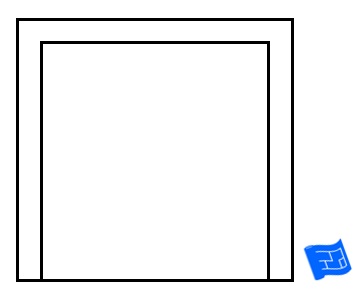- Home
- Countertop Design
Countertop Designs
You'll need to figure out countertop designs for several different areas of your home. The obvious rooms being your kitchen, bathrooms and laundry and other spaces such as utility rooms or the mud room. You might even find yourself thinking about countertops as part of built in cabinets in your home such as your walk in closet or living room cabinetry.
This page is packed with general information on countertop designs all in the name of helping you make decisions about your countertops throughout. I talk about different countertop materials and elements of countertop design.
There's also specific information on countertops in different rooms.
Kitchen countertop
(coming soon)
Bathroom countertop
(coming soon)
Countertop materials
Choosing the material for your countertops is an important part of your countertop designs. There are a number of materials to choose from with new ones being developed from time to time.
I've reviewed the most common countertop materials to help you make your decision.
Each review discusses the properties or attributes of the material, the pros and cons and finally a few words of advice on whether or not the material would be a good choice for your countertop designs.
Here's a lis of the properties or attributes to compare when you're considering which material to use for your kitchen countertop.
- Aesthetic considerations (what it looks like)
- Seams
- Stain resistance
- Heat resistance
- Scratch resistance
- Cleanliness - how easy is the surface to keep clean, and does the surface repel or absorb germs and bacteria?
- Cost

A quick tip on comparing costs
Most materials have various different pricing levels. A fashionable color in Corian might set you back more than a piece of readily available granite. It’s important to look around and pick out the specific options you like for a cost comparison. When dealing with manufacturers get them to give you a quote which includes all materials, installation and any sealing if required.
If you’re planning to order an integrated sink with one of your countertop choices, make sure you add the cost of a sink and installation to your other options to get a true comparison of cost.

Mix and match countertop materials
There’s no rule that says that your choice of material has to be the same for every countertop surface. Some really nice designs can be achieved by mixing and matching countertop design ideas. Let’s look at an example. Let’s say you love the look of wood. This might not be the ideal choice for the high traffic areas on your countertops but there might be other areas of the countertop where you can allow practically to be less of a priority. So you can go ahead and include more than one countertop choice.
Elements of countertop designs
You might think that a countertop is just a flat piece of material that fits on top of your cabinets, but if we look carefully a countertop can be deconstructed into a number of design elements which go together to make up the overall design of the countertop.
I use three different attributes to describe a countertop:
- Thickness - this is pretty self explanatory
- Projection - this is a measure of how far the countertop overhangs the cabinets
- Profile - The shape of the edge of the countertop
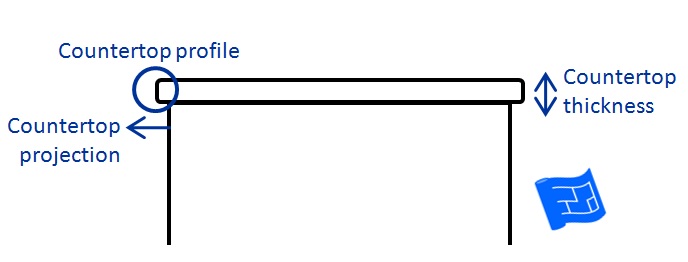 I describe kitchen countertops using the concepts of thickness, projection and profile. Click through for more information on countertop design and home design.
I describe kitchen countertops using the concepts of thickness, projection and profile. Click through for more information on countertop design and home design.There's some pictures lower down that illustrate different combinations of thickness, projection and profile.

Countertop template
The planning process for your countertop whichever room it's in usually includes a stage where a template is drawn for the countertop. This is a real size template of the countertop and it's important that you pay attention and check and double check that everything is as you want it to be before your countertop is cut or made.
Countertop thickness
You might think that getting a thicker countertop is going to cost more because there's more material required. However some fabricators have a method of creating a countertop where the 'nose' is thicker than the rest of the countertop, so it shouldn't cost you too much more to have a 'thick look' countertop.
Countertop projection
Here's some words to describe countertop projection.
When thinking about projection it's all in relation to your the depth of your base cabinets. Be aware of the depth of your frame, how far the doors and drawers lie in front of the frame (or if they're flush with the frame) and the door hardware you're planning to use.
Keep your frame, doors & drawers and hardware in mind when you're thinking about the projection of your countertop.
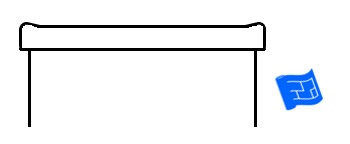 Consider having a slightly raised edge to your countertop to prevent spills spilling onto the floor.
Consider having a slightly raised edge to your countertop to prevent spills spilling onto the floor.
Natural profiles
There are several natural materials available for countertop designs like stone, marble or wood. One idea for you is that if you're using one of these natural materials, you could allow the natural grain of the material determine the shape of the edge of the countertop rather than getting everything cut in to straight lines.

Backsplash sill
As well as the horizontal part of the countertop you can choose to include a backsplash sill in your countertop design. That's where you carry the countertop material up the wall at the back for between 4 and 6 inches / around 10 - 15 cm. These backsplash sills also have a thickness and a profile for you to think about. Typically the thickness is less than the countertop.
Countertop designs in action
So let's look at a few countertop designs with different thicknesses, projections and profiles.
These profiles aren't the only designs, it's just to give you an idea about the different looks that can be created.
Bear in mind that profiles which include straight lines and sharp corners are more prone to breaking if something heavy enough is dropped onto the edge of the counter.
 How about a thin profile countertop? This one sits flush with the base cabinets and has a straight profile.
How about a thin profile countertop? This one sits flush with the base cabinets and has a straight profile.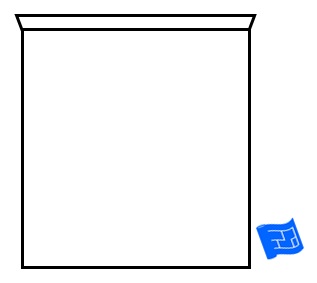 Here we have a standard thickness countertop with a wedge shape profile starting flush with the base cabinets and extending beyond it slightly.
Here we have a standard thickness countertop with a wedge shape profile starting flush with the base cabinets and extending beyond it slightly.The thick profiles which follow could be made with a thinner countertop. It just made sense to show them as thick here to make them easier to see.
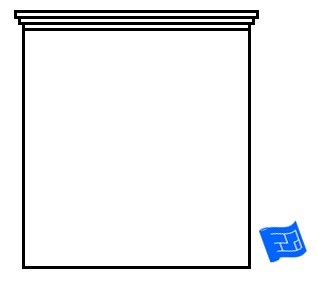 This countertop has a straight stepped profile starting flush with the countertop and extending out.
This countertop has a straight stepped profile starting flush with the countertop and extending out.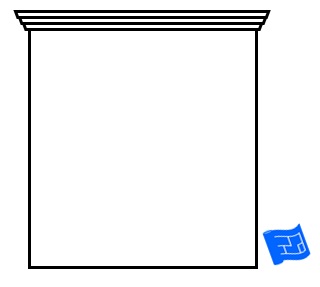 This countertop profile is three wedge shaped steps. The countertop starts with some projection from the base cabinets.
This countertop profile is three wedge shaped steps. The countertop starts with some projection from the base cabinets.Adding a spacer to raise the countertop above the base cabinets creates some interesting designs.
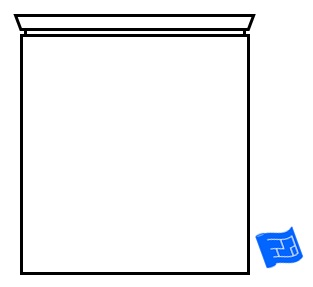 A wedge profile with a space between the countertop and the base units. This countertop projects out from the base cabients slightly.
A wedge profile with a space between the countertop and the base units. This countertop projects out from the base cabients slightly.Fancy countertop shapes
Fancy countertop shapes give a luxury feel, but they go hand in hand with the design of the cabinets below because the fancy shapes need support from the cabinets underneath. So if you want a fancy countertop design, choose your cabinets accordingly.
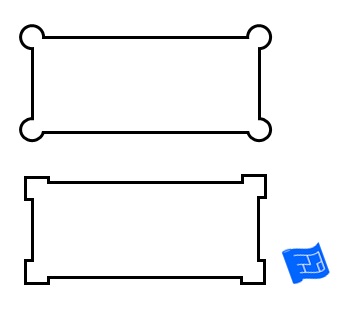
So that rounds up this page on countertop designs. See the links below for more...

